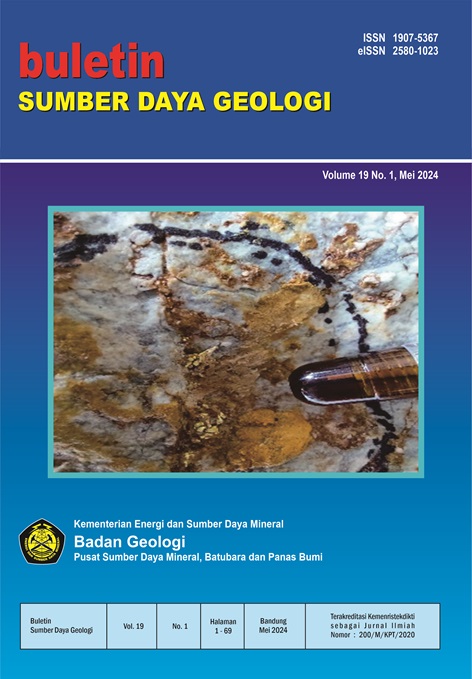KARAKTERISITIK ENDAPAN POLIMETALIK EMAS DAN LOGAM DASAR DAERAH DOLOK PANGKURUHAN, KECAMATAN PEGAGAN HILIR, KABUPATEN DAIRI, PROVINSI SUMATERA UTARA
CHARACTERISTICS OF POLYMETALLIC GOLD AND BASE METAL DEPOSITS DOLOK PANGKURUHAN AREA, PEGAGAN HILIR DISTRICT, DAIRI REGENCY, NORTH SUMATRA PROVINCE
Abstract
Several previous investigative activities in the Dolok Pangkuruhan area, Dairi Regency, North Sumatra Province have discovered several locations of gold and base metal mineralization. This article discusses the characteristics of alteration and mineralization of gold and base metals based on the results of investigations in 2023 with the aim of determining the characteristics of alteration and mineralization as well as a deposit type model. The research methods used include semi-detailed geological mapping, alteration and mineralization, XRD analysis, spectral analysis, mineralography, and fluid inclusion analysis. The alteration that develops consists of: argillic, advanced argillic, phyllic-pyrite and phyllic-silicification. There are four types of mineralization: a. Au-galena veins (Dolok Pangkuruhan) which are characterized by the presence of native gold and crystalline and colloform vein textures; b. Galena mineralization, sphalerite (Aek Sulfi), with massive and banded texture characteristics; c. quartz-silicification-sphalerite-galena vein (Sembilin River); d. quartz-bornite-chalcopyrite vein (Sikiring- kiring River). The results of fluid inclusion analysis are interpreted as epithermal deposits with mineralization formation temperatures ranging from 240°C – 346°C. Based on paragenetic sequence analysis, the mineralization characteristics can be interpreted as a model of polymetallic deposits (Au-Pb and Zn-Pb-Cu) of medium - high sulphide epithermal vein type.
Downloads
References
Aldiss, D.T., Whandoyo, R., 1983, Peta Geologi Lembar Sidikalang dan (Sebagian) Sinabang Sumatra, Pusat Penelitian dan Pengembangan Geologi, Bandung.
Bartels, K. S., 1994, Graphite and C-O-H fluids in metabasites from the Continental Deep Drilling Program, Germany (KTB), paper presented at Vllth International Symposium on the Observation of the Continental Crust through Drilling, Santa F6, N.M., April 25-30, 1994.
Baden, K., 2016, Paleoproterozoic hydrothermal graphite-sulfide+gold mineralization from the Tasiilaq area, South-East Greenland. Denmark.
Corbett and Leach, T.M.,1998, Southwest Pacic Rim Gold-Copper Systems: Structure, Alteration, and Mineralization, Society of Economic Geologists, https://doi.org/10.5382/SP.06
Dzil, M.A, Nursahan, I., Andhi, 2023, Laporan Penyelidikan Geologi, Geokimia dan Geofisika Logam Mulia Kecamatan Pegagan Hilir, Kabupaten Dairi, PSDMBP-Badan Geologi, Bandung.
Hatta, M.H., Dzil, M. A dan Rudy, G., 2017, Laporan Penyelidikan Logam Mulia Logam dasar Kecamatan Pegagan Hilir, Kabupaten Dairi, PSDMBP-Badan geologi, Bandung.
Herald Resources Ltd,1998, The Dairi Zinc-Lead Project, North Sumatra, Indonesia, PT Dairi Prima Mineral, North Sumatra Province.
Lee, A, Alexander, P. Gysi, Nicole, C. H., Thomas, M, Katharina, P.,, 2020, Porphyry-related polymetallic Au-Ag vein deposit in the Central City district, Colorado: Mineral paragenesis and pyrite trace element chemistry, Ore Geology Reviews Volume 119, April 2020, 103295;
Lydon, J.W., 1996, Sedimentary Exhalative Sulphides (Sedex); in Geology of Canadian Mineral Deposit Types, Geology of Canada, Vol 8 Geological Survey of Canada.
Morrison, K. 1995. Magmatic-related Hydrothermal System. Australia: Short Course Manual.
Putz, H., Paar W.H., and Topa, D., 2009, A Contribution to The Knowledge Of The Mineralization At Mina apillitas, Catamarca, https://www.researchgate.net /publication/262544084_Aportes_alconocimiento_de_la_mineralizacion_de_mina_Capillitas_Catamarca/
Reyes, A.G. 1990. Petrology of Philippine Geothermal System and the Application of Alteration Mineralogy to Their Assesment. Journal of Volcanology and Geothermal Research, v.43.
Reyes, A.G. 1990a. Petrology of Philippines geothermal systems and the application of alteration mineralogy to their assessment: Journal of Volcanology and Geothermal Research, v. 43.
Reyes, A.G. 1990b. Mineralogy, distribution and origin of acid alteration in Philippine geothermal systems, in Third symposium on deep-crust fluids. 15-16 October 1990, Tsukuba, Japan, extended abstracts: Tsukuba, Geological Survey of Japan.
Reyes, A.G., Giggenbach, W.F., Saleros, J.D.M., Salonga, N.D., dan Vergara, M.C. 1993. Petrology and geochemistry of Alto Peak, a vapour-cored hydrothermal system, Lyete Province, Philippines, in Sussman, D., Ruaya, J.R., Reyes, A.G., and Hedenquist, J.W., eds., Geothermal systems of the Philippines: Geothermics, v. 22.
White, N.C., Hedenquist, W. 1995. Epithermal Gold Deposits: Styles, Characteristics and Exploration. SEG Newsletter No. 23.
Wilkinson, J.J. (2001). Fluid inclusions in hydrothermal ore deposits. Lithos, v.55, pp.229–272.
Zhu, Y.F., An, F., Tan, J., (2011). Geochemistry of hydrothermal gold deposits: Areview: Geoscience Frontiers. Vol. 2, Issue 3 p. 367–374.
Copyright (c) 2024 Buletin Sumber Daya Geologi

This work is licensed under a Creative Commons Attribution-NonCommercial-ShareAlike 4.0 International License.
Authors whose manuscripts are published agree to the following terms:
The publication rights of all journal manuscript materials published on the Buletin Sumber Daya Geologi website are held by the editorial board with the knowledge of the author (moral rights remain with the manuscript’s author).
The formal legal provisions for access to digital articles in this electronic journal are subject to the terms of the Creative Commons Attribution-ShareAlike (CC BY-SA) license. This means that Buletin Sumber Daya Geologi has the right to store, convert media/formats, manage in the form of a database, maintain, and publish the article without requesting permission from the author, as long as the author’s name is cited as the copyright holder.
Manuscripts published in both print and electronic formats are open access for educational, research, investigative, and library purposes. Beyond these purposes, the editorial board is not responsible for any violations of copyright law.















